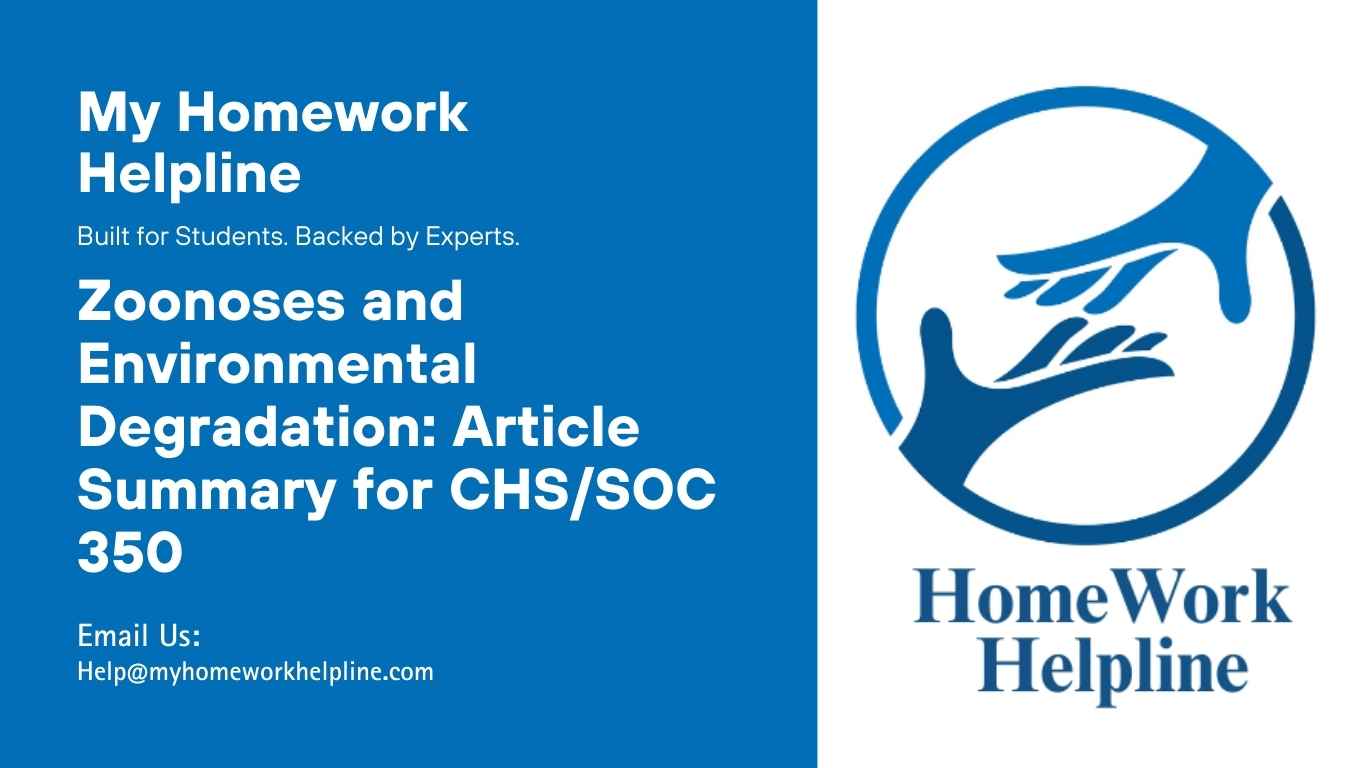Zoonoses and Environmental Degradation Article Summary from CHS/SOC 350
Part 1: Concepts
Sample:
| Embeddedness | A concept from economic sociology is that markets and the economy are always part of (or “embedded”) in society. (Granovetter 1985) |
| Concept | Definition |
| Zoonoses | It is a concept from sustaining global surveillance and response to emerging zoonotic diseases. They are more often illnesses that the community is not medically ready to treat, an example being, HIV/AIDS and the mad cow disease (Keusch et al., 2009). |
| Deforestation | A concept from environmental conservation studies to clear the forested land within the society. It is clearing land, especially trees, without further replenishment. |
| Environmental degradation | A concept from environmental conservation that spouts the deterioration of the surroundings through the depletion of core resources within the environment (Keusch et al., 2009). Some eliminated resources, including air, water, and soil, destroy the ecosystem. |
If you’re working on complex topics like zoonoses, deforestation, or environmental degradation, having expert guidance can make your studies much easier. Our team at environmental science homework assistance provides detailed support for essays, article summaries, and research papers. Whether you’re managing case studies or tackling challenging assignments, we simplify the process while helping you improve academic performance. Start building confidence in your coursework with professional support tailored to your needs.
Part II: Take-Aways
| Citation of resource
(APA or Chicago Format) |
1. Main topic/Takeaway |
| 2. An exciting finding from reading | |
| Sample (from actual student):
Erickson, Jim. 2016, Jan 19. Targeting minorities, low- income neighbourhoods for hazardous waste sites. University of Michigan: Michigan News. Retrieved from: https://news.umich.edu/targeting-minority-low-income-neighborhoods-for-hazardous-waste-sites/ |
Minority and low-income neighbourhoods are targeted by industries when deciding where to put their hazardous waste sites and polluting facilities (which we know leads to the declining health of low-income communities). In this University of Michigan study, previous university studies were looked at to determine “clear patterns of racial and socioeconomic disparities in the distribution of a large variety of environmental hazards.” (Erickson, 2016, p. 2) |
| – The author had a hole in their logic, which is mentioned on page 3 of the text. It would be a slim outcome for the hazard facilities to attract a change in demographic but rather force one. These facilities would drive property values down, making neighbourhoods like these prime candidates for low-income housing.
– I like the author’s explanation of “the path of least resistance,” especially with the added term ‘political clout .’It was a thoughtful explanation for us or those who might think that “least resistance” means that the low-income community let this happen. |
|
| (Keusch et al., 2009)
Sustaining Global Surveillance and Response to Emerging Zoonotic Diseases |
Zoonotic diseases are some of the major global threats to public health. They have subjected the underlying nation to comprehensive scrutiny due to increased mortality rates with minimal sustainability cases. Infectious disease surveillance systems have been portrayed as protecting the health of human beings and animals (Keusch et al., 2009). Traditionally, zoonotic diseases were regarded as illnesses with the capacity and capability to infect humans and animals. The global surveillance system can lay down the track for the outbreak of new illnesses within the community. Zoonoses are an unpredictable type of disease within society, and they exhibit a wide range of effects on the general population within the environment. They threaten human and animal health simultaneously with minimal recovery incidences. The zoonoses exhibit varying pathophysiology with diverse mutations of strains that increase severity within the society. The current trends in the healthcare system depict that zoonotic diseases are rapidly increasing in number within society, which poses a threat to human and animal health. Some contributing factors that drive the increase in the spread of zoonotic diseases in cross-country infection are the increased rate of international trade, travel, and the movement of infected animals. |
| – It is worth noting that the spread of zoonotic diseases within the environment adopts significant economic distress to several industries within the environment. Both agricultural and hospitality industries are affected by the outbreak of zoonotic diseases within society, which derails the nation’s economic output.
– The proposed method of global surveillance of zoonotic diseases will result in effective control and moderation of the spread of the condition. The system will consider the health status of all animals that moves from one place to another. |
|
| Lyme Disease: Diagnosis and Treatment | Black-legged ticks are some of the population’s most important vectors for Lyme disease. The ancient prevalence of these vectors was rare, but with the current transformations in climate change, there has been an increase in the breeding of these ticks (Schoen, 2020). They infect children with a disease that is fatal to their health. The symptoms of the illnesses have been mostly misdiagnosed, resulting in the death of several individuals within the environment. In most cases, the disease has been politicized, endangering people’s lives. There was a risk of false testing and over-testing of Lyme disease that led to the dismission of symptoms among the patients. |
| – I feel like the article pinpoints the aspect of politicizing diseases and illnesses. In this case, it is strange for doctors to face legal action when prescribing antibiotics for Lyme disease patients. They were also subjected to substantial legal fees and loss of license. The activities led to an increased prevalence of Lyme disease.
– The spread of Lyme disease is not a natural element but a lifestyle and influence emerging from biodiversity. |
|
References
National Research Council. (2010). Sustaining global surveillance and response to emerging zoonotic diseases. http://ssu.ac.ir/cms/fileadmin/user_upload/Daneshkadaha/dbehdasht/zoonosis_center/book/_Committee_on_Achieving_Sustainable_Global_Capacit_BookZZ.org_.pdf
Schoen, R. T. (2020). Lyme disease: diagnosis and treatment. Current opinion in rheumatology, 32(3), 247-254. https://journals.lww.com/co-rheumatology/Fulltext/2020/05000/Lyme_disease__diagnosis_and_treatment.7.aspx?context=LatestArticles

